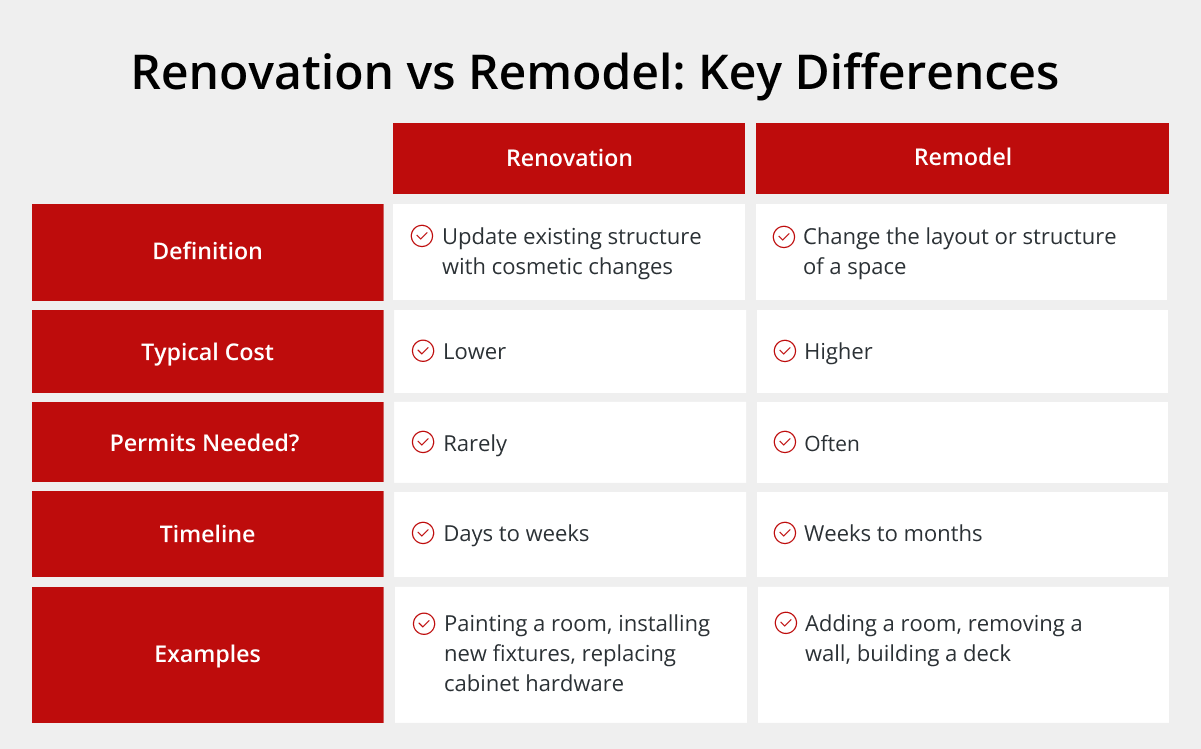Renovation vs Remodel: What’s the Difference?
KEY TAKEAWAYS
- Renovations update existing features while keeping the original layout, whereas remodels change the structure or configuration of your space.
- Renovations typically cost less and take less time since they work within existing structures, while remodels involve more complex work that requires permits and professional planning.
- Smaller renovations can often be funded through personal loans or credit cards, while major remodels may require specialized financing like construction or home equity loans.
- Your goals will determine the right choice. If you want to refresh your space’s appearance and functionality, renovation works well, but if you need to change how your space functions or flows, you’ll likely need a remodel.
Planning to update your home but confused about whether you need a renovation or remodel? You’re not alone. Many homeowners use these terms interchangeably, but understanding the difference between remodel and renovation can save you time, money, and headaches down the road.
Whether you’re looking to refresh your kitchen cabinets or completely reconfigure your floor plan, knowing which approach fits your goals will help you make smarter decisions about your project scope, budget, and timeline. So, what’s the difference between remodel and renovation? Keep reading to find out.

What Is a Renovation?
A renovation focuses on restoring or updating existing features in your home without changing the basic structure or layout. It’s essentially giving your space a fresh look and improved functionality while working within the current framework.
Common renovation projects include:
- Repainting walls
- Replacing kitchen cabinets
- Refinishing hardwood floors
- Updating light fixtures
- Installing new countertops
These improvements enhance your home’s aesthetics and can boost functionality, but the fundamental layout stays the same.
Renovations often involve cosmetic updates that breathe new life into tired spaces. You might update your bathroom with new tile, fixtures, and vanity, but the toilet, shower, and sink remain in their original locations. The room looks completely different, but the underlying structure and plumbing layout haven’t changed.
Since renovations work within existing structures, they typically require fewer permits and less professional oversight than more extensive projects. This makes them appealing options for homeowners who want significant visual impact without the complexity of structural changes.
What Is a Remodel?
A remodel involves changing the structure, layout, or configuration of a space. This means removing or adding walls, relocating plumbing or electrical systems, changing room sizes, or completely reconfiguring how a space functions.
Remodeling projects typically have a much larger scope than renovations. You might remove the wall between your kitchen and dining room to create an open layout, add a bathroom to an unused space, or convert your garage into a living area. These changes alter the fundamental structure and flow of your home.
Because remodels involve structural changes, they usually require building permits, architectural plans, and professional contractors who understand local building codes. The timeline for remodel vs. renovate projects differs significantly, with remodels taking weeks or months compared to days or weeks for most renovations.
Remodeling costs more than renovation work because it involves more complex labor, materials, and planning. However, major remodels can also provide substantial returns on investment, especially when they improve your home’s functionality or add square footage.
Key Differences Between Renovation and Remodel

Understanding the difference between remodel vs renovation comes down to several factors that affect your project, such as:
- Scope and complexity: Renovations focus on surface-level improvements and updates within existing structures. Remodels involve changing the actual structure, layout, or systems in your home. If you’re keeping walls in place and updating what’s already there, you’re renovating. If you’re moving walls or changing room configurations, you’re remodeling.
- Cost & time: Renovations typically cost less because they use existing infrastructure. You might spend $15,000 to $30,000 renovating a kitchen by updating cabinets, appliances, and finishes. A kitchen remodel that changes the layout could easily cost $50,000 to $100,000 or more. Renovations also finish faster since there’s less demolition and rebuilding involved.
- Permits: Most renovation projects don’t require building permits, though you might need permits for electrical or plumbing updates. Remodels almost always require permits because they involve structural changes, and you’ll likely need architects, engineers, or specialized contractors to ensure the work meets building codes.
Which Is Right for You: Renovation or Remodel?
Choosing between renovation and remodel depends on your specific goals, budget, and home’s current condition. Start by honestly evaluating what you want to achieve.
If your primary goals are improving aesthetics, updating outdated features, or enhancing functionality within your current layout, renovation probably makes sense. Maybe your kitchen cabinets are worn, but the layout works well for your family. Renovating with new cabinets, countertops, and appliances can transform the space without the expense and disruption of moving plumbing or electrical systems.
Consider a remodel when your current layout doesn’t meet your needs, you want to add square footage, or your home’s configuration feels outdated. Families who feel cramped might benefit from removing walls, or you might want to convert unused space into functional rooms.
Your budget will have a major influence on this decision. Renovations offer more predictable costs and shorter timelines, making them appealing if you have limited funds or need to complete work quickly. On the other hand, remodels require larger budgets and more flexibility with timing, but they can provide more dramatic improvements.
Think about your long-term plans, too. If you’re planning to sell within a few years, strategic renovations might provide better returns on investment. If this is your forever home, a remodel that perfectly suits your family’s needs could be worth the extra investment.
Financing a Renovation vs Remodel
Different projects often require different financing approaches based on the scope, timeline, and total cost involved.

For renovations, you have several straightforward options:
- Personal loans work well for smaller projects, typically offering fixed rates and predictable monthly payments.
- A home equity line of credit gives you flexible access to money, letting you draw as needed throughout your project.
- For minor updates, credit cards might make sense, especially if they offer promotional interest rates.
Remodels often require more specialized financing due to their larger scope and extended timelines. You should compare different types of financing, like second mortgages and HELOANs, to ensure you’re making the right decision. You can finance remodels using:
- An FHA 203(k) loan, which combines purchase and renovation costs into a single mortgage.
- A construction loan that provides funding in stages as work progresses, which works well for extensive remodeling projects.
- A cash-out refinance that lets you tap into your home’s equity by refinancing for more than you owe and taking the difference in cash. Refinancing for home improvements can be a great idea if rates are favorable and you want to consolidate your project funding with your primary mortgage.
- A home equity loan that provides lump-sum financing with fixed rates.
Common Renovation and Remodel Projects
Understanding typical projects in each category helps clarify the difference between remodel and renovation projects in practical terms.
Popular renovation projects include:
- Painting interior and exterior surfaces
- Replacing flooring throughout the home
- Updating kitchen or bathroom fixtures
- Installing new countertops
- Upgrading appliances
- Refinishing existing cabinets
- Adding new lighting fixtures
- Updating hardware like door handles and faucets
Common remodel projects involve:
- Creating open-concept living spaces by removing walls
- Adding rooms to your home
- Converting basements, attics, or garages into living spaces
- Completely reconfiguring kitchen or bathroom layouts
- Adding or relocating plumbing and electrical systems
- Installing new windows or doors in different locations
- Building additions like sunrooms or expanded master suites
Mistakes to Avoid When Planning Renovations or Remodels
It’s easy for homeowners to make costly mistakes when planning home improvement projects. Avoiding these pitfalls can save you money, time, and frustration:
- Starting without a clear goal or budget: Define exactly what you want to achieve and research realistic costs for your area before committing to any approach. Underestimating expenses is particularly common with remodels, where structural surprises can quickly inflate budgets.
- Not understanding permit requirements: Many homeowners assume that renovation work doesn’t need permits, but electrical, plumbing, and structural work often needs approval regardless of project scope. Check with your local building department early in the planning process.
- Choosing the wrong type of financing or underestimating costs: Don’t use high-interest credit cards for major remodels, and avoid borrowing more than necessary for simple renovations. Match your financing choice to your project’s scope, timeline, and your financial situation.
Find an Approach That Works for You

Whether you choose renovation or remodel depends on your specific needs, goals, and circumstances. Both approaches can dramatically improve your home’s comfort, functionality, and value when planned and executed properly.
Griffin Funding offers various financing solutions to support your home improvement goals, from traditional home equity loans to specialized renovation loans. We can help you find loan options that match your project scope and financial situation.
Download the Griffin Gold app to explore your mortgage options, manage your finances, and access mortgage-specific calculators and tools. If you’re ready to begin your home buying journey, get started online today.
Find the best loan for you. Reach out today!
Get StartedFrequently Asked Questions
How much does a remodel cost vs renovation? 
The difference between renovation and remodel costs stems from the complexity of work involved, with remodels requiring permits, professional design, and more extensive labor.
How does renovation differ from restoration? 
What are considered major renovations? 
Recent Posts
Capital Gains Tax on Home Sale Calculator
Capital Gains Tax on Sale of Primary Residence Calculator What Is Capital Gains Tax on a Home Sale? Capital ga...
Closing Cost Calculator
Try Our Closing Cost Calculator What Are Closing Costs? Closing costs are the collection of fees and expenses ...
Rent Estimator: Get a Free Rent Estimate
Rent Estimator Use our free rent estimator to get an instant estimate for any property address and start maxim...



